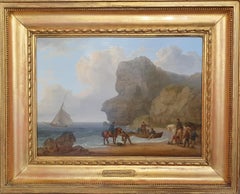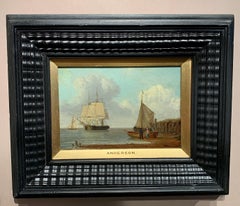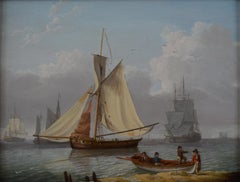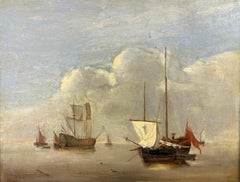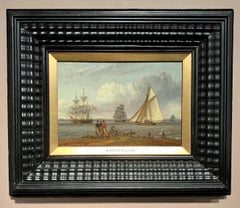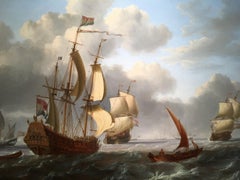William Anderson Landscape Paintings
British, 1757-1837
William (or Wiliam) Anderson (1757 – 27 May 1837) was a Scottish artist specializing in maritime and patriotic themes. He was well-regarded for his detailed and accurate portraits of ships under sail, exhibiting his works annually in London between 1787 and 1811 and then occasionally until 1834. Anderson influenced other artists, notably John Ward and others of the Hull school. Anderson's early life is obscure, but he is known to have trained as a shipwright before moving to London to become a maritime painter when he was about 30. His training served him well as a painter, providing "a practical nautical knowledge" of his subjects. He earned a reputation for "accuracy and refinement of detail" and was admired for his bright, clear colours. He worked in both oils and watercolours.
He based his style on that of well-known Dutch maritime painters of the 17th century. He first exhibited at the Royal Academy in 1787 and the Royal Institution in 1810, and continued to exhibit annually until 1811. He then exhibited intermittently until 1834.[6] His best work was executed in the years 1790–1810, during the French Revolutionary and Napoleonic Wars, at which time the demand for naval paintings was high. His painting was not restricted to marine subjects and included an exhibit in 1822 of a painting depicting the Battle of Waterloo. Like other artists of the time, Anderson's paintings of marine incidents were often based on sketches by participants and were bought by individuals who had risen in social standing and wealth during the wars.
Commissions that took Anderson back north introduced him to the Hull school of painters, notably influencing the young John Ward (1798–1849), who copied at least one of Anderson's paintings. He was also a friend and possibly a collaborator of the painter Julius Caesar Ibbetson (1759–1817). His work was influenced by his travels in the North, which led to depictions of Berwick-on-Tweed and Tynemouth. His last exhibit was of Lord Howe's fleet at Spithead at the Royal Academy in 1834, the last of 45 paintings that he exhibited there. He died in London on 27 May 1837.(Biography provided by David Brooker Fine Art)
to
1
2
1
3
3
3
Overall Height
to
Overall Width
to
1
3
3
1
1
1
1
1
2
1
3
556
251
225
178
3
3
1
1
Artist: William Anderson
Marine painting sea shore smugglers boat scotttish 19th
By William Anderson
Located in PARIS, FR
William ANDERSON (1757- 1837) Oil on wooden panel 25.5 x 34.5 cm (40x50cm with frame) Signed and dated lower left "W. Anderson / 1817" Collector's stamp on the back
Scottish painte...
Category
1810s Romantic William Anderson Landscape Paintings
Materials
Oil
Antique English 19th century marine scene
By William Anderson
Located in Woodbury, CT
Outstanding English late 18th / early 19th century marine scene by one of Britain's best known and sought after painters.
William (or Wiliam) Anderson (1757 – 27 May 1837) was a Scottish artist specializing in maritime and patriotic themes. He was well-regarded for his detailed and accurate portraits of ships under sail, exhibiting his works annually in London between 1787 and 1811 and then occasionally until 1834. Anderson influenced other artists, notably John Ward and others of the Hull school.
Anderson's early life is obscure, but he is known to have trained as a shipwright before moving to London to become a maritime painter when he was about 30. His training served him well as a painter, providing "a practical nautical knowledge" of his subjects. He earned a reputation for "accuracy and refinement of detail" and was admired for his bright, clear colours. He worked in both oils and watercolours.
He based his style on that of well-known Dutch maritime...
Category
1810s Old Masters William Anderson Landscape Paintings
Materials
Oil, Wood Panel
"Shipping off the Coast, " (possibly Isle of Wight)
By William Anderson
Located in ludlow, GB
WILLIAM ANDERSON
British 1757 - 1837
"Isle of Wight"
Oil on Panel.
The painting is not signed though it is undoubtedly of his hand. It has the label f...
Category
Late 18th Century William Anderson Landscape Paintings
Materials
Oil
Related Items
Shipping in Calm Waters, 18th Century Dutch Oil on Wood Panel, Man o War
Located in Cirencester, Gloucestershire
Shipping in Calm Waters
Dutch School, 18th century
oil painting on wood panel
panel: 10 x 12.75 inches
framed: 14 x 17 inches
condition: very good, minor evidenc...
Category
18th Century Old Masters William Anderson Landscape Paintings
Materials
Wood Panel, Oil
Baroque Dutch painter - Late 18th century figure painting - Inn Interior - Oil o
Located in Varmo, IT
Dutch painter (18th-19th century) - The spanking.
60 x 99 cm without frame, 67 x 106 cm with frame.
Antique oil painting on wood, without frame.
Condition report: Wooden support s...
Category
Late 18th Century Old Masters William Anderson Landscape Paintings
Materials
Oil, Panel
Italian Landscape With Figures at a Waterfall by a Follower of Jan van Huysum
By Jan Van Huysum
Located in Stockholm, SE
There are so many details to fall in love with in this 18th-century painting depicting an Italianate landscape, for example, the delicately painted figures having a conversation and ...
Category
Early 18th Century Old Masters William Anderson Landscape Paintings
Materials
Oil, Wood Panel
Free Shipping
H 9.65 in W 13.98 in
#3671
By Hiro Yokose
Located in Phoenix, AZ
oil and wax on canvas over panel
Neoromantic painter Hiro Yokose fuses multiple layers of wax and oil paint to create mysterious, veiled landscapes illuminated with flashes of ligh...
Category
Early 2000s Romantic William Anderson Landscape Paintings
Materials
Wax, Oil, Panel, Wood Panel, Canvas
Small Neapolitan fishermen. XIX century. With Gulf of Naples and Vesuvius
Located in Firenze, IT
Small Neapolitan fishermen with girl.
XIX century.
Foreign artist active in Italy.
Painting representing two children against the background of the Gulf of Naples with the volcano...
Category
19th Century Romantic William Anderson Landscape Paintings
Materials
Oil, Canvas
Free Shipping
H 25.6 in W 22.05 in D 2.37 in
Macbeth and the Three Witches a Painting on Panel by Francesco Zuccarelli
By Francesco Zuccarelli
Located in PARIS, FR
This painting, created during Zuccarelli's stay in England, represents the decisive moment when Macbeth, together with Banquo, meets the three witches who announce that he will be Ki...
Category
1760s Old Masters William Anderson Landscape Paintings
Materials
Oil, Wood Panel
17th century Dutch seascape - Stormy sea with a Dutch Hoy - Marine Boats
Located in Antwerp, BE
17th century Dutch old master oil seascape, Stormy sea with boats including a Dutch Hoy and a Packet-Boat
The present painting is a peaceful, yet very lively, seascape and a beautif...
Category
17th Century Old Masters William Anderson Landscape Paintings
Materials
Oil, Panel
#3022
By Hiro Yokose
Located in Phoenix, AZ
oil and wax on canvas
Neoromantic painter Hiro Yokose fuses multiple layers of wax and oil paint to create mysterious, veiled landscapes illuminated with flashes of light in the sky...
Category
1990s Romantic William Anderson Landscape Paintings
Materials
Canvas, Wax, Oil
The Old Bridge, 27th September 1914
Located in Cotignac, FR
Early 20th Century, French, oil on canvas of a romantic river scape with an ancient bridge. The work is dedicated, signed and dated bottom left, but we have not been able to decipher...
Category
Early 20th Century Romantic William Anderson Landscape Paintings
Materials
Canvas, Oil
Moses Strikes the Water from the Rock. XVII cent. Dutch school.
Located in Firenze, IT
Moses Strikes Water from the Rock Dutch school, XVII century. Workshop of Jacob de Wet (Haarlem, 1610-1675).
Technique: Oil on oak wood panel, composed of 3 horizontal panels.
In this evocative work, Moses stands in a cave, gathering the Israelites. There was no water to drink or for their cattle. The people were discontented in the desert.
But Moses and Aaron listened to the voice of God. With Aaron’s staff, Moses struck the rock, and water gushed forth abundantly, quenching their thirst.
Jacob de Wet’s workshop specializes in subjects from the Old and New Testaments.
The recognizable rectangular format, simple compositions, and clear narratives define his style. The interplay of light and shadow, reminiscent of Rembrandt, adds timeless allure. The characters’ costumes, with their large hats and turbans...
Category
17th Century Old Masters William Anderson Landscape Paintings
Materials
Oil, Wood Panel
Early oil depicting the Great Fire of London
Located in London, GB
The Great Fire of London in September 1666 was one of the greatest disasters in the city’s history. The City, with its wooden houses crowded together in narrow streets, was a natural fire risk, and predictions that London would burn down became a shocking reality. The fire began in a bakery in Pudding Lane, an area near the Thames teeming with warehouses and shops full of flammable materials, such as timber, oil, coal, pitch and turpentine. Inevitably the fire spread rapidly from this area into the City. Our painting depicts the impact of the fire on those who were caught in it and creates a very dramatic impression of what the fire was like. Closer inspection reveals a scene of chaos and panic with people running out of the gates. It shows Cripplegate in the north of the City, with St Giles without Cripplegate to its left, in flames (on the site of the present day Barbican). The painting probably represents the fire on the night of Tuesday 4 September, when four-fifths of the City was burning at once, including St Paul's Cathedral. Old St Paul’s can be seen to the right of the canvas, the medieval church with its thick stone walls, was considered a place of safety, but the building was covered in wooden scaffolding as it was in the midst of being restored by the then little known architect, Christopher Wren and caught fire. Our painting seems to depict a specific moment on the Tuesday night when the lead on St Paul’s caught fire and, as the diarist John Evelyn described: ‘the stones of Paul’s flew like grenades, the melting lead running down the streets in a stream and the very pavements glowing with the firey redness, so as no horse, nor man, was able to tread on them.’
Although the loss of life was minimal, some accounts record only sixteen perished, the magnitude of the property loss was shocking – some four hundred and thirty acres, about eighty per cent of the City proper was destroyed, including over thirteen thousand houses, eighty-nine churches, and fifty-two Guild Halls. Thousands were homeless and financially ruined. The Great Fire, and the subsequent fire of 1676, which destroyed over six hundred houses south of the Thames, changed the appearance of London forever. The one constructive outcome of the Great Fire was that the plague, which had devastated the population of London since 1665, diminished greatly, due to the mass death of the plague-carrying rats in the blaze.
The fire was widely reported in eyewitness accounts, newspapers, letters and diaries. Samuel Pepys recorded climbing the steeple of Barking Church from which he viewed the destroyed City: ‘the saddest sight of desolation that I ever saw.’ There was an official enquiry into the causes of the fire, petitions to the King and Lord Mayor to rebuild, new legislation and building Acts. Naturally, the fire became a dramatic and extremely popular subject for painters and engravers. A group of works relatively closely related to the present picture have been traditionally ascribed to Jan Griffier...
Category
17th Century Old Masters William Anderson Landscape Paintings
Materials
Oil, Canvas
Adam and Eve in paradise, studio of Jan Brueghel the Younger, 17th century
Located in PARIS, FR
Studio of Jan Brueghel the Younger
17th century Antwerp school
Oil on oak panel, h. 37 cm, w. 49 cm
Tortoiseshell veneered baroque style frame...
Category
Mid-17th Century Old Masters William Anderson Landscape Paintings
Materials
Oil, Wood Panel
Previously Available Items
Antique English 19th century marine scene
By William Anderson
Located in Woodbury, CT
Outstanding English late 18th / early 19th century marine scene by one of Britain's best known and sought after painters.
William (or Wiliam) Anderson (1757 – 27 May 1837) was a Scottish artist specializing in maritime and patriotic themes. He was well-regarded for his detailed and accurate portraits of ships under sail, exhibiting his works annually in London between 1787 and 1811 and then occasionally until 1834. Anderson influenced other artists, notably John Ward and others of the Hull school.
Anderson's early life is obscure, but he is known to have trained as a shipwright before moving to London to become a maritime painter when he was about 30. His training served him well as a painter, providing "a practical nautical knowledge" of his subjects. He earned a reputation for "accuracy and refinement of detail" and was admired for his bright, clear colours. He worked in both oils and watercolours.
He based his style on that of well-known Dutch maritime...
Category
1810s Old Masters William Anderson Landscape Paintings
Materials
Wood Panel, Oil
18th century Dutch warships at sea off with fishing boats in full sail
By William Anderson
Located in Woodbury, CT
William Anderson was born in Scotland in 1757, though the precise details of date and place are elusive. He trained initially as a shipwright, but by the age of thirty was an accompl...
Category
1780s Old Masters William Anderson Landscape Paintings
Materials
Oil
Free Shipping
H 12 in W 16 in
William Anderson landscape paintings for sale on 1stDibs.
Find a wide variety of authentic William Anderson landscape paintings available for sale on 1stDibs. You can also browse by medium to find art by William Anderson in oil paint, paint, panel and more. Much of the original work by this artist or collective was created during the 19th century and is mostly associated with the Old Masters style. Not every interior allows for large William Anderson landscape paintings, so small editions measuring 10 inches across are available. William Anderson landscape paintings prices can differ depending upon medium, time period and other attributes. On 1stDibs, the price for these items starts at $6,360 and tops out at $8,672, while the average work can sell for $6,360.
